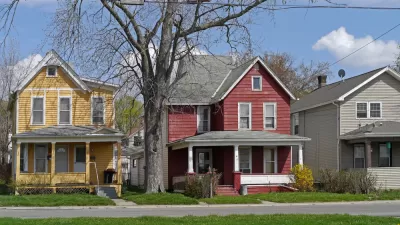A California state law that allowed temporary property tax reductions to homeowners during the housing crash is now swinging back the other way. Some homeowners have seen 20 percent increases in property tax bills.
Dan Walters shares news a report by the California Legislative Analyst's Office that predicts big increases for property taxes as the state's real estate market improves—at percentages much higher than the Proposition 13 would typically allow.
Writes Walters: "Proposition 13, passed by voters in 1978, limits annual increases in taxable values to 2 percent, but state tax law also allows temporary decreases in those values to be fully recovered later if the market increases. Increases of up to 20 percent were reported during the 2013-14 fiscal year, based on the 2012 market rise."
An article by Cate Long, has more details on Proposition 8, the state legislation that allowed the reduction of property tax values—reducing property tax revenues by $7 billion. "After the housing crash, a California state law, Proposition 8, allowed temporary property tax reductions for 3.2 million properties — about 2.6 million homes and 600,000 other properties. Under Prop 8, property assessments were allowed to be lowered to match the market value of the property. According to a recent legislative report, these reductions dragged down local government revenues by approximately 15 percent."
The increase in property tax revenues will come as especially good news for state spending on schools, reports Walters: "The $7 billion reduction in local property tax revenues also affected the state budget because the state was required to make up the schools' losses of about $3.2 billion. Therefore, the increases in property values and property taxes not only are increasing revenues to local governments but reducing the state's constitutionally required level of education spending."
FULL STORY: As California property values rise, owners see big tax bill hikes

Planetizen Federal Action Tracker
A weekly monitor of how Trump’s orders and actions are impacting planners and planning in America.

San Francisco's School District Spent $105M To Build Affordable Housing for Teachers — And That's Just the Beginning
SFUSD joins a growing list of school districts using their land holdings to address housing affordability challenges faced by their own employees.

The Tiny, Adorable $7,000 Car Turning Japan Onto EVs
The single seat Mibot charges from a regular plug as quickly as an iPad, and is about half the price of an average EV.

Seattle's Plan for Adopting Driverless Cars
Equity, safety, accessibility and affordability are front of mind as the city prepares for robotaxis and other autonomous vehicles.

As Trump Phases Out FEMA, Is It Time to Flee the Floodplains?
With less federal funding available for disaster relief efforts, the need to relocate at-risk communities is more urgent than ever.

With Protected Lanes, 460% More People Commute by Bike
For those needing more ammo, more data proving what we already knew is here.
Urban Design for Planners 1: Software Tools
This six-course series explores essential urban design concepts using open source software and equips planners with the tools they need to participate fully in the urban design process.
Planning for Universal Design
Learn the tools for implementing Universal Design in planning regulations.
Smith Gee Studio
City of Charlotte
City of Camden Redevelopment Agency
City of Astoria
Transportation Research & Education Center (TREC) at Portland State University
US High Speed Rail Association
City of Camden Redevelopment Agency
Municipality of Princeton (NJ)





























